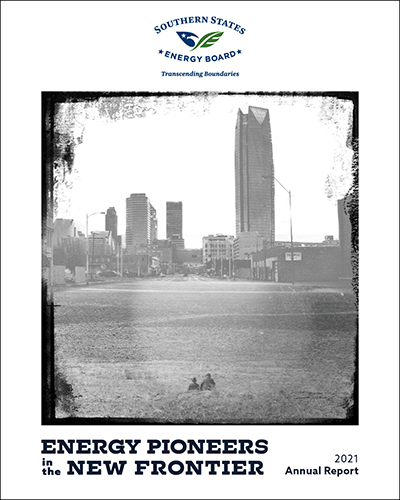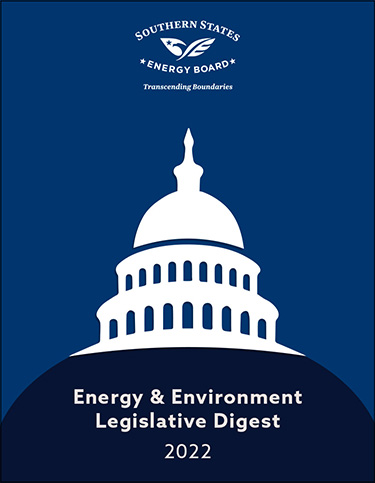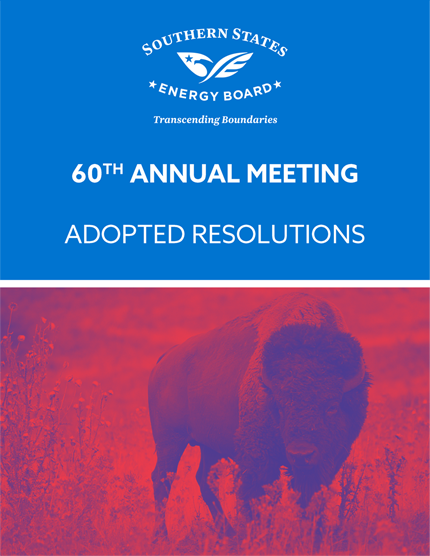Ahead of our 61st Annual Meeting, we’ve released this year’s Annual Report.
Chairman’s Message Excerpt
From Oklahoma’s Governor Kevin Stitt:
For the 61st Annual Meeting of the Southern States Energy Board, I chose the theme, Energy Pioneers in the New Frontier. Our Nation is entering a period of unprecedented change and transition in the energy sector that includes all facets of energy, including production, transmission, environmental protection, transportation infrastructure, and workforce development. How we consume energy is changing every day.
The challenges before us are enormous, but with this change comes great opportunity. As we take these challenges head on, it is important that we recall the giants upon whose shoulders we stand today. In Oklahoma, they were pioneers like Frank and Waite Phillips, Bill Skelly, and E.W. Marland, or modern-day titans like T. Boone Pickens, Harold Hamm, and Aubrey McClendon who paved the way for Oklahoma to be a world leader in energy production.
Oklahoma and its oil & gas industry have always been pioneers and innovators in energy and can claim many of the most important events in history. We proudly recall the history of oil being discovered before the territory became a State: on April 15, 1897, a wooden oil derrick named the Nellie Johnstone No. 1 in Bartlesville, Indian Territory, enabled a plume of crude oil and water to burst through the earth, ushering a new oil industry into what would become Oklahoma. That well became the State’s first commercial oil enterprise and drew over 100,000 barrels of oil over a period of 50 years. The process of hydraulic fracturing was invented in 1949 by Halliburton in Duncan, Oklahoma, while that same technology was later combined with horizontal drilling by other Oklahoma companies who are responsible for creating the shale revolution.
We are long removed from the time when oil derricks were scattered across the prairies, and Sooners, as they were called, used the oil they collected to grease parts from their wooden wagons. When drilling began in 1897, it would take six wagons to drag a wooden rig, sometimes over a hundred miles to the drilling site.
Today, we are a premier energy producing state that has taken our “all of the above” energy policy to the next level. We remain a leader in our proud tradition of producing fossil energy, but most people are surprised to learn that Oklahoma is a leader in renewables and alternative energy. We are one of only four states in the U.S. to get more than 40 percent of our power from renewables. Our wind resources are so legendary that they were canonized in our State by Rodgers & Hammerstein.
Our unique mix of natural gas and renewables has yielded remarkable environmental results. Oklahoma has reduced its carbon dioxide emissions from the power sector by three times the national average as measured against the 2005 benchmark used by the Biden Administration. Using the latest numbers from the U.S. Energy Information Administration (EIA), Oklahoma has reduced its CO2 from the power sector by 35 percent while the national average is only 12 percent. We have done so while remaining the most affordable energy in the country in 9 of the last 11 quarters, according to EIA. We believe Oklahoma can legitimately boast that we have the cleanest and most affordable energy in the country.
I am proud to be Chairman of the SSEB, because it allows us to support our member states in maximizing the use of their resources in the way that is most beneficial to their citizens and states. I strongly believe that these types of policy and resource decisions are best made by state and local governments allowing the markets and trends to guide their choices. Today, we see consumers and investors demanding cleaner sources of energy with less emissions. We are proud that Oklahoma and the Southern States Energy Board are leaders in meeting those demands in a sensible and affordable way.
Since its inception in 1960, the Southern States Energy Board has been a part of our region’s pioneering spirit. From the Board’s role at the outset of nuclear power development to the age of carbon management, and from the technological innovations that cleared sulfur and nitrous oxides from our Appalachian Mountain air to the development of an interstate mechanism for remediation of environmental permitting, SSEB has been an active and strident supporter of strong state responses to energy and environmental issues.
In February of this year, the Board’s Carbon Management Program grew through final award of a new project that will test an emerging technology for direct air capture of carbon dioxide (CO2). Partners include AirCapture LLC , Crescent Resource Innovation, Global Thermostat, the National Carbon Capture Center, Southern Company, and Synapse. The Technology will be designed and tested in a fabrication facility and then transported to the National Carbon Capture Center in Wilsonville, Alabama. The direct air capture skids will be integrated into the center’s facility for operational testing. Design activities are underway now and testing will begin in 2023.
Last September, the SSEB Carbon Management Team began Phase 3 of our CarbonSAFE project, also referred to as Project ECO2S. The purpose of this activity is to determine the feasibility for establishing a CO2 storage complex in Mississippi. Critical path milestones for this venture include ensuring compliance with the National Environmental Policy Act and pursuing a U.S. Environmental Protection Agency (EPA) Underground Injection Control Class VI permit for CO2 storage, which will be the first for a Southern States Energy Board carbon management project since the Class VI final rule was established by EPA in 2010. To date, our team has drilled three stratigraphic test wells and one groundwater test well to further assess the suitability of the geology within our area of interest. Seismic data acquisition was completed earlier this year, and data assessment is underway. This endeavor has the most partners of any Board program.
The Southeast Regional CO2 Utilization and Storage Acceleration Partnership, or SECARB-USA, is the follow-on phase to our highly successful SECARB project. The scope of our activities focuses on addressing key technical challenges to carbon capture, utilization, and storage (CCUS); data collection, sharing and analysis; transportation and distribution infrastructure; and promoting regional technology transfer and knowledge dissemination. During the past year, our team has been examining the geology within the southern region for future technology deployment opportunities and determining infrastructure needs to connect CO2 sources to storage reservoirs or areas where CO2-enhanced recovery options may exist. The maps and routing simulations created by the team will assist developers in identifying routes that have the least human and environmental impact. Our expert team of stakeholders also has identified impediments to CCUS deployment and determined additional work that the partners will perform to eliminate these challenges.
SSEB’s assessment of CCUS opportunities in Southwest Arkansas has shown very positive results. This evaluation was requested by Governor Asa Hutchinson. The Board and its partner, Advanced Resources International, Inc., (ARI) first performed a screening study of CO2 storage and enhanced oil recovery options, which was funded by the State. Upon completion of the initial screening, the project was transferred into our SECARB project in order to use existing funding to perform more robust analyses.
On June 23, SSEB, Governor Hutchinson, Secretary of Commerce Mike Preston, Public Service Commission Chairman and Governor’s Alternate to SSEB Ted Thomas, ARI, and CRI jointly hosted a Southwest Arkansas Revitalization Workshop in El Dorado, Arkansas. The event coincided with the 100th anniversary of the January 1921 discovery of oil In Union County, Arkansas. The workshop presenters covered many aspects of the opportunity for revitalization of the oil and gas industry in Southwest Arkansas, including the concept of CCUS, why it is a viable commercial opportunity in El Dorado and surrounding areas, the legal and regulatory frameworks surrounding CCUS, asset financing options, and suitable business models and case studies.
The Southern States Energy Board’s CCUS Offshore Partnership recently received approval for its second and final phase of work. The results of the project will include high prospect areas for future offshore CCUS project development in the eastern Gulf of Mexico. This venture also will culminate in a guidance document on the legal, regulatory, and technical feasibility of offshore CO2 subsea storage projects, as well as a prospect-specific feasibility assessment for infrastructure development, operations, and decommissioning.
Another agreement that has received a five-year renewal is our project that supports the Transuranic, or TRU, Waste Transportation Working Group. These are state officials that coordinate the interstate shipments of TRU waste to the Waste Isolation Pilot Plant in Carlsbad, New Mexico. The project also enables SSEB to provide direct funding to states for full time staff who monitor these shipments, engage in emergency response planning, direct emergency responder training, and procure equipment. The Working Group meets twice per year, and our staff is in constant communication with the states on shipment schedules, training opportunities, coordination, and purchasing needs.
SSEB also serves as the staff for the Southern Emergency Response Council created by Southern Governors in 1972. The Council, with SSEB serving as the Secretariat, administers the Southern Mutual Radiation Assistance Plan (SMRAP) which provides mutual aid from state to state in the event of an emergency occurring at any of the region’s nuclear power plants. SMRAP is vigorously tested annually.
The Southern States Energy Board has provided innovative technical and policy leadership over many decades while being mindful of the socio-economic impacts of our actions on generations to come. The SECARB, SECARB-USA, Project ECO2S, SECARB Offshore, and Direct Air Capture projects exemplify the pioneering spirit and effectiveness of public-private partnership collaborations in designing, developing, and demonstrating the clean energy technologies of the future. However, the Board has recognized a significant need to assemble a larger group of industry stakeholders and experts to promote the rapid and transformative deployment of CCUS technologies – commercially and at a much larger scale.
Last September, we announced our collaboration with the University of Houston’s Center for Carbon Management in Energy. We are applying lessons learned and experiences in our R&D projects and demonstrations to develop a Commercialization Consortium that will accelerate CCUS deployment. We also are engaging a Leadership Team of industry and subject matter experts to provide visionary strategies in our development of a roadmap designed to achieve CCUS commercialization. The Leadership Team is composed of representatives from 33 major U.S.-based energy companies that are committed to providing us with assistance to further identify and offer solutions to remaining uncertainties impeding industry investments in CCUS technologies. We are excited to work with such an impressive group of industry stakeholders, many of whom are Associate Members!
Assembling our members and project partners in virtual meetings has become a common means of communication and collaboration for our staff since the onset of the pandemic in 2020. At SSEB, we held our first large, virtual conference just over a year ago and have hosted over 250 virtual meetings and webinars since our last Board meeting.
Earlier this year, we initiated a webinar series. This is not meant to replace our meetings but offers a unique way to gather for an hour and learn about technologies or issues that are of importance to our member states. The first webinar, held February 25th, analyzed the growing pace of electric vehicle adoption in the Southeast and examined the industry and policy response. The second event occurred on March 11th and focused on innovations in electric vehicle batteries and new facilities planned for southern states. Two subsequent webinars have focused on Regional Initiatives for Carbon Capture and Storage and SSEB’s SECARB-USA Partnership.
During the past two years of my Chairmanship, we have seen great change as a constant. The pandemic has created great strain on all of us. It has changed the way we are able to work, the way we meet, the way we deliver services, but it has also revealed the needs from health care to transportation or how the demand for energy can change so quickly. We learned to be ready for anything. I am not sure any of our member states was fully prepared for the polar vortex that hit the south last February. With temperatures remaining well below freezing for 10 days, we saw new winter peaks and unprecedented disruptions and millions without power during this powerful storm. We are seeing northern and northwestern states experiencing heatwaves causing similar disruptions in the power grid causing problems. Our work here in the SSEB is more important than ever.
With all these changes, these pioneers are facing a new frontier and we are spearheading an “all of the above” approach to energy policy. We choose energy that is produced locally, that is affordable, and that is reliable. We are a leader in wind generation and other renewable resources, ranking #2 nationally in wind production. As one of four states that receives 40 percent of our electricity from renewable resources, we have embraced a future that enables us to produce power locally and export 28 percent of our energy to neighboring states.
SSEB’s enormous portfolio of current projects and programs exceeds $457 million in 2021, a phenomenal amount considering the size of the staff. What I have focused on above is merely a part of the range of activities that are the Board’s emphasis this year. Since October 2020, SSEB has generated more than $34 million in new public-private partnerships that include energy industry, state, and federal funding. The majority of these funds support member states and territories through contracts and subawards with state agencies, colleges and universities, utility partners, energy research organizations, national laboratories, energy resource companies, and businesses in our southern region.
It is a privilege for me to serve as the Chairman of such a vigorous and constructive organization that constantly is transcending boundaries and closing the gaps between policy and technology applications!





